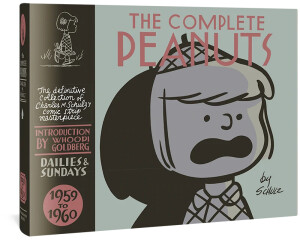 The Complete Peanuts is an on-going labour of love for editor Gary Groth and designer Seth. And it’s a semi-regular treat to receive the next volume. This is the fifth book so far and we’re up to 1959-60. I was eight years old, and reading the comics for myself, so some of these simple strips are starting to look familiar to me. Of course, many of them have been reprinted in paperbacks or in deluxe versions over and over, but always in “selected” collections. Never before has the collected work of Charles Schulz been made available in this way. And credit must be given to Groth and Seth for the detail and love that have gone into this presentation.
The Complete Peanuts is an on-going labour of love for editor Gary Groth and designer Seth. And it’s a semi-regular treat to receive the next volume. This is the fifth book so far and we’re up to 1959-60. I was eight years old, and reading the comics for myself, so some of these simple strips are starting to look familiar to me. Of course, many of them have been reprinted in paperbacks or in deluxe versions over and over, but always in “selected” collections. Never before has the collected work of Charles Schulz been made available in this way. And credit must be given to Groth and Seth for the detail and love that have gone into this presentation.
Whoopi Goldberg provides the foreword this time ’round and it’s an edited transcript of an interview with Gary Groth. She recalls her early response to Peanuts and remembers interviewing Schulz one time on her talk show. He volunteered to colour in her tattoo of Woodstock. She wears this inkstain proudly on her breast! Why Woodstock? She says, “. . . there was something really wonderful about this bird who would just hang out, who wasn’t concerned about a lot of stuff. He had a good friend in Snoopy. . . [it’s] wonderful to carry that chirp with me. . . when I see the tattoo I think of him just talking to me, as he would to Snoopy. It’s kind of dopey but I love it.”
That’s kind of representative of everybody’s response to the whole Peanuts cast, isn’t it? “Kind of dopey but I love it.” Of course, there’s much more than dopiness inherent in Schulz’s clean and simple line drawings. These four panel strips are the essence of modern life, reduced to elemental form by a master craftsman, and he made it seem so easy!
From the first strip in the book, January 1959, wherein Lucy provides Linus with a sheet of paper, a list she’s compiled of all his faults, the truths are laid bare. “Faults! You call these faults! These aren’t faults,” he retorts, “These are character traits!” Schulz would run with a theme for a day, or a week, until he had investigated it. For instance, Charlie Brown asks Lucy why she would do such a thing as list people’s faults. Her answer is that it’s because she has high ideals, she “want[s] to make this world a better place to live in.” Then the next day, when she provides as multi-page list to Snoopy he chases her with fangs bared. Charlie Brown reminds her, “Some people don’t like to have their faults pointed out. . . .” This is real life. These scribbles are real people. It’s kind of dopey, but I love it.
There is also the surrealism of Snoopy’s fantasy life, the naive and wonderful examples of child’s play, and hidden just under the surface Schulz’s political comments and philosophy. This is why Peanuts was (and continues to be) so influential. It’s timeless. Any political comments were generic not specific, not tied to current events but rather to common sense principles. Any philosophy was generic enough so as to fit into any number of belief systems, and still let the reader know that thieir was a faith system at the base of the whole story.
When I read the first volume of The Complete Peanuts I found myself laughing out loud at every second or third strip. There are still guffaws that occur regularly, but now I find myself marvelling more at the mind behind it all. Every page, every single strip made me feel better, made me smile, or recall with longing an earlier, more innocent time.
The sub-title to the whole set is “The definitive collection of Charles M. Schulz’s comic strip masterpiece,” not one of those words is overstatement! I can’t wait for the next volume, and the next, and the next. . . .
(Fantagraphics Books, 2006)
